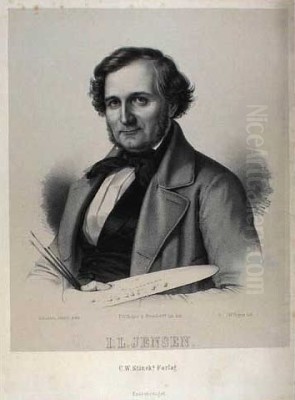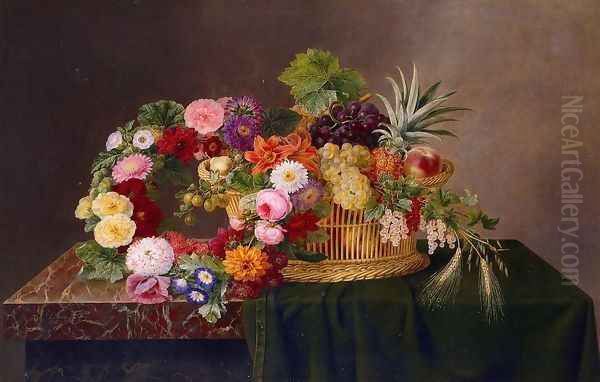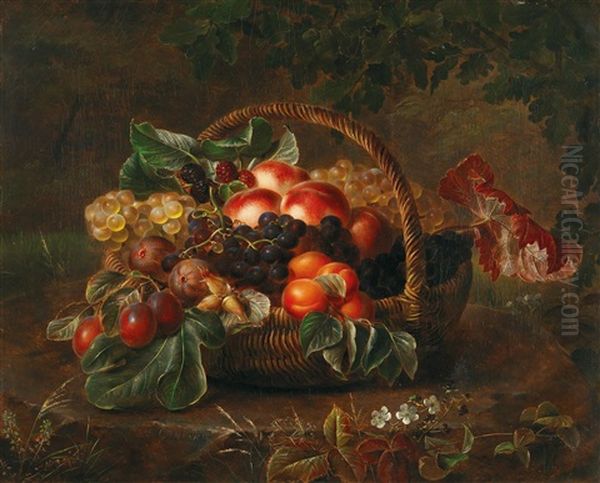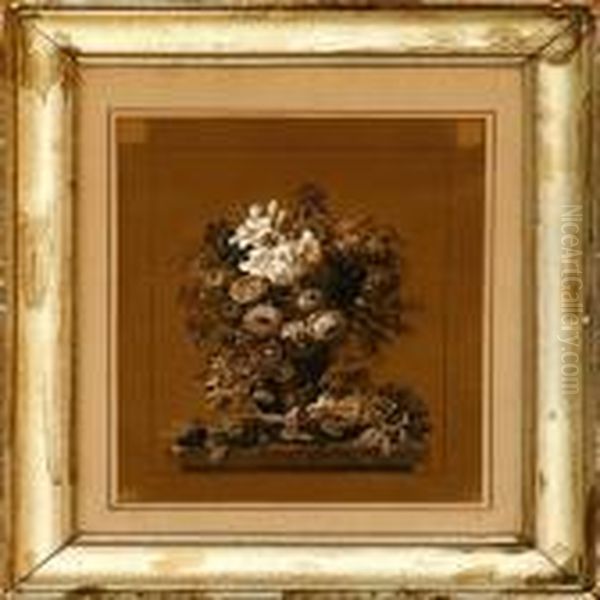Introduction to a Danish Golden Age Talent

Johan Laurentz Jensen, often referred to as J.L. Jensen, stands as a pivotal figure in the history of Danish art, particularly celebrated for his mastery of flower painting during the 19th century. Born in Copenhagen on March 8, 1800, and passing away in the same city on March 26, 1856, Jensen's life and career unfolded during the vibrant period known as the Danish Golden Age. While this era is often associated with landscape and genre painting, Jensen carved a distinct and influential niche for himself, reviving and elevating the status of still life, especially floral compositions, within the Danish art scene. His dedication to the genre earned him the affectionate and respectful title, "Father of Danish Flower Painting."
Jensen's artistic journey began within the esteemed halls of the Royal Danish Academy of Fine Arts in Copenhagen. Here, he received foundational training that would shape his technical proficiency. The Academy, during this period, was a crucible of talent, fostering many artists who would define the Golden Age. Jensen's education provided him with the essential skills in drawing, composition, and color theory, preparing him for a career dedicated to capturing the intricate beauty of the natural world, albeit in carefully arranged settings. His specialization in floral still life became his defining characteristic, setting him apart from many contemporaries focused on other subjects.
Formative Years and Influences
At the Royal Danish Academy, Jensen studied under prominent figures who were instrumental in shaping the Danish Golden Age. One key mentor was Christoffer Wilhelm Eckersberg (1783-1853), widely regarded as the "Father of Danish Painting." Eckersberg, known for his emphasis on careful observation, precise rendering, and the study of light and perspective, instilled a sense of discipline and realism in his students. Though Eckersberg himself was more focused on historical scenes, portraits, and landscapes, his rigorous teaching methods undoubtedly influenced Jensen's meticulous approach to detail.

Another significant teacher for Jensen at the Academy was Cladius Detlev Fritzsch (1765-1841). Fritzsch was himself a noted painter of flowers and portraits, providing Jensen with more direct guidance in his chosen specialization. Fritzsch's own work bridged the gap between earlier decorative traditions and the burgeoning realism of the Golden Age, offering a relevant model for the young Jensen as he began to develop his own style within the genre of floral painting. The combination of Eckersberg's foundational principles and Fritzsch's genre-specific expertise provided a strong starting point for Jensen's artistic development in Copenhagen.
Parisian Studies and the Dutch Tradition
Seeking to further refine his skills, particularly in the specialized art of flower painting, Jensen traveled to Paris. This move was crucial, exposing him to international trends and techniques beyond the Danish context. In Paris, he sought out masters renowned for their floral work, studying under the Flemish brothers Gerard van Spaendonck (1746-1822) and Cornelis van Spaendonck (1756-1839). Both brothers were highly respected flower painters working in the rich tradition inherited from Dutch Golden Age masters like Jan van Huysum and Rachel Ruysch.
Gerard van Spaendonck, in particular, was a leading figure, known for his botanically accurate yet artistically refined depictions of flowers. He had studied earlier under Jacob Herreyns in Antwerp before achieving fame in Paris. The Spaendoncks emphasized detailed observation, delicate brushwork, and sophisticated compositions, often featuring luxurious bouquets against neutral backgrounds. Studying with them allowed Jensen to immerse himself in this established European tradition, learning techniques for rendering textures, capturing the play of light on petals and leaves, and arranging complex floral assortments that were both naturalistic and aesthetically pleasing.
Jensen's Parisian experience was further enriched by his time studying miniature flower painting techniques at the famous Sèvres porcelain factory. Cornelis van Spaendonck had connections there, eventually becoming its artistic director. This training honed Jensen's ability to work with extreme precision and detail, skills valuable not only for potential work on porcelain but also transferable to his oil paintings, enhancing the jewel-like quality of his floral depictions. The combination of academic training, exposure to the Dutch floral tradition via the Spaendoncks, and the meticulousness required by Sèvres equipped Jensen with a formidable technical arsenal.
Artistic Style: Realism and Romance
Johan Laurentz Jensen developed a distinctive style characterized by a blend of meticulous realism and a subtle romantic sensibility. His primary subjects were flowers, often presented in elaborate bouquets housed in vases or baskets. He frequently incorporated fruit, and occasionally birds or insects, adding narrative or symbolic layers to his compositions. His commitment to botanical accuracy was evident; individual species are usually identifiable, rendered with careful attention to their specific forms, colors, and textures.

A hallmark of Jensen's technique is his skillful handling of light and shadow. He often employed dark, atmospheric backgrounds, a technique reminiscent of Dutch Golden Age still lifes, which served to dramatically highlight the vibrant colors and delicate forms of the flowers and fruit. This contrast created a sense of depth and focused the viewer's attention on the central subject. His rendering of surfaces, from the velvety softness of rose petals to the cool transparency of glass vases or the fuzzy skin of a peach, demonstrates exceptional technical prowess.
While grounded in realism, Jensen's works often possess a decorative quality and an underlying symbolic resonance. The choice and arrangement of flowers could carry traditional meanings associated with vanitas (the transience of life and beauty) or simply celebrate the abundance and splendor of nature. He masterfully combined native Danish flora with exotic species, reflecting contemporary horticultural interests and perhaps symbolizing a connection between the local and the global. His compositions, though carefully constructed, often convey a sense of natural vitality and lushness, appealing to the Romantic era's appreciation for the beauty and power of nature.
Representative Works
Several paintings stand out as representative of Jensen's oeuvre and artistic concerns. "Still Life With Dahlias" is a prime example of his mature style. It showcases his ability to capture the complex forms and rich colors of these popular flowers, set against a typically dark background that enhances their luminosity. The play of light across the petals and leaves is rendered with exquisite detail, demonstrating both botanical accuracy and artistic sensitivity. The composition feels abundant yet balanced, a testament to his skill in arrangement.
"A Basket With Fruit" highlights his versatility within the still life genre. Here, the focus shifts to a collection of fruits, likely including grapes, peaches, and plums, overflowing from a woven basket. Jensen applies the same meticulous attention to detail in rendering the varied textures and colors of the fruit, capturing their ripeness and appeal. Such works demonstrate his mastery of different natural forms and his ability to create compositions that are both realistic and aesthetically satisfying, often evoking a sense of harvest and plenty.

Another notable work, sometimes titled "A Bouquet Of Colorful Flowers," exemplifies his skill in creating complex, multi-species floral arrangements. These bouquets often feature a mix of cultivated and wild flowers, showcasing a diverse range of forms and colors. Jensen's ability to harmonize these varied elements into a cohesive and visually stunning whole is remarkable. Works like "Still Life With Grapes, Blackberries, Orange And Pineapple" further demonstrate his interest in combining different textures and forms, including exotic fruits like the pineapple, which would have been a luxury item, adding a touch of the exotic to the composition. His painting "Pansies in a Greek Bowl" (or similar titles referring to pansies) often carries a more intimate, poetic feeling, focusing on the delicate beauty and symbolic associations of these flowers.
Career, Recognition, and Royal Patronage
Jensen's talent did not go unnoticed during his lifetime, although his full stature as a major figure might have been more clearly recognized posthumously. He achieved considerable success and held respected positions. For a period, he served as the chief painter at the prestigious Royal Copenhagen Porcelain Factory, a role that directly utilized the skills he had honed, possibly including his studies at Sèvres. His ability to render detailed floral motifs was highly valued in this context.
He was also actively involved in the academic art world of Copenhagen. From 1835, he held a position as a member and professor at the Royal Danish Academy of Fine Arts, contributing to the education of the next generation of artists. His work was regularly exhibited at the annual Charlottenborg Spring Exhibition in Copenhagen, the premier venue for Danish artists to display their work. He also gained international exposure, participating in exhibitions such as the Expo Universelle in Paris.
Jensen enjoyed patronage from high circles, including the Danish royal family. Queen Louise, the wife of King Christian IX, was known to have collected his work. He received commissions for decorative paintings, sometimes related to significant royal events like weddings, further cementing his status within the Danish establishment. Despite this success, some art historical accounts suggest that the genre of still life painting, even when executed at Jensen's high level, might have been considered less prestigious than history painting or portraiture by some conservative elements within the art world of the time, potentially tempering his contemporary fame compared to his lasting legacy.
The Danish Golden Age Context
To fully appreciate Johan Laurentz Jensen's contribution, it's essential to view him within the context of the Danish Golden Age (roughly the first half of the 19th century). This period saw an extraordinary flourishing of arts and sciences in Denmark. In painting, the era was largely defined by Jensen's own teacher, Eckersberg, and his pupils. These artists turned away from the highly dramatic styles of the late Baroque and focused on depicting Danish landscapes, everyday life, and portraits with a sense of realism, intimacy, and often an underlying Biedermeier sensibility.

Key figures of the Golden Age alongside Eckersberg include Christen Købke, known for his sensitive landscapes and portraits; Constantin Hansen, famous for his Italian scenes and portraits of the intellectual elite; Wilhelm Bendz, a master of genre scenes and complex interior portraits; Martinus Rørbye, who traveled widely and depicted scenes from Italy, Greece, and Turkey as well as Denmark; and J. Th. Lundbye, celebrated for his evocative paintings of the Danish landscape. Even the great neoclassical sculptor Bertel Thorvaldsen, though primarily based in Rome, was a towering figure associated with this era.
While landscape, portraiture, and genre scenes dominated the Golden Age, Jensen's dedication to still life provided an important counterpoint. He applied the era's characteristic emphasis on careful observation, realism, and the sensitive depiction of light to the realm of flowers and fruit. His work demonstrated that still life could be a vehicle for profound artistic expression, technical virtuosity, and emotional resonance, aligning with the Golden Age's broader project of finding beauty and significance in the observable world, whether it be a Zealand landscape or a meticulously rendered bouquet of roses.
Influence and Legacy
Johan Laurentz Jensen's impact on Danish art, particularly in the realm of still life, was significant and lasting. His revival and modernization of flower painting set a high standard and inspired subsequent generations of artists. By combining the technical polish of the Dutch tradition with the sensibilities of the Danish Golden Age and a touch of Romanticism, he created a body of work that was both deeply rooted in history and distinctly his own.
His role as "Father of Danish Flower Painting" is well-deserved. He demonstrated that this genre could achieve a level of artistry and sophistication comparable to other forms of painting. His influence extended through his teaching at the Academy. Among his students was Carl Bloch (1834-1890), who, although later becoming more famous for his historical and religious paintings, also produced still lifes early in his career that show Jensen's influence. While the claim of Hans Christian Andersen being a formal painting student is less substantiated (Andersen was primarily a writer, though he did draw and make papercuts), Jensen's circle would have certainly included many prominent cultural figures of the time.
Jensen's works remain highly sought after and are held in major Danish museums, including the Statens Museum for Kunst (National Gallery of Denmark) and numerous regional collections, as well as international galleries and private collections. His paintings continue to be admired for their technical brilliance, decorative beauty, and the way they capture the ephemeral charm of flowers and fruit with enduring artistry. He secured a permanent place for floral still life within the canon of Danish art history.
Later Life and Enduring Appeal
In his later years, Jensen reportedly spent more time in the countryside near Copenhagen. His focus during this period sometimes shifted towards depicting simpler arrangements, including wildflowers gathered from local fields and meadows, or straightforward compositions of fruit in baskets. These later works often retain his characteristic use of dark backgrounds and meticulous attention to detail, but perhaps with a more direct, less elaborate approach compared to some of his grander, earlier bouquets.
He continued to paint until his death in Copenhagen in 1856 at the age of 56. His passing marked the end of a career dedicated to the beauty of the botanical world. The enduring appeal of Jensen's work lies in its combination of objective accuracy and subjective artistry. He was not merely a botanical illustrator; he was an artist who used flowers and fruit as his medium to explore themes of beauty, transience, light, color, and form.
Today, Johan Laurentz Jensen is recognized as the foremost Danish flower painter of his century. His paintings offer a window into the aesthetics and horticultural interests of the Danish Golden Age, while simultaneously transcending their time through their sheer visual appeal and technical mastery. His legacy is preserved not only in the museums that house his work but also in the continuing appreciation for the genre he so expertly championed. He remains a testament to the profound beauty that can be found and expressed through the careful observation and artistic interpretation of the natural world.